The 1st Generation Ford Mustang
1964.5 – 1973
On Friday, April 17th, 1964, the world was forever changed with the introduction of an all-new breed of sports car. The Ford Mustang arrived in Dearborn, Michigan and created a pandemonium unlike anything seen by the Ford Motor Company prior to its introduction. Demand for the Ford Mustang almost instantaneously overwhelmed the company’s ability to produce the incredibly popular automobile. Feuds to purchase the car were common and created an incredible amount of hype that only further escalated the demand for this iconic sports car.
While it would be easy to say that Ford had simply developed a better breed of pony-car and that the “rest is history,” there is actually a lot more to the story – and the origin – of the Ford Mustang. As we begin the narrative of the Ford Mustang, a sweeping story which weaves its way through the many pages of MustangSpecs.com, we knowingly take a few moments to reflect back on the pioneers that breathed life into the earliest Mustangs. We pay homage to the visionaries that recognized the need to design and build a sports car that would change future generations of automotive enthusiasts – as well as the Ford Motor Company – forever.
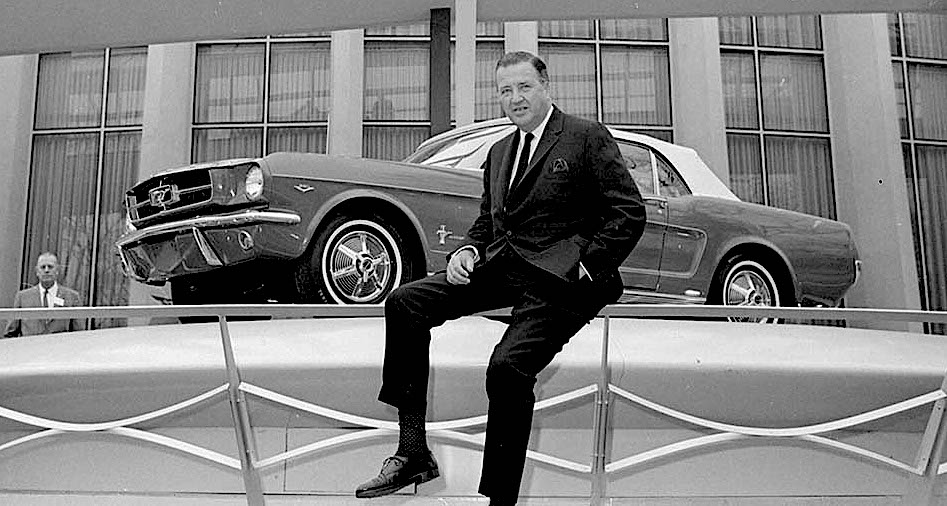
Visions of the Future
The origin of the Mustang shares roots with another long-hood, two-seat sports car that had been developed by Ford in early 1950’s and introduced to the world in 1955 – the Ford Thunderbird. The Thunderbird had been developed by Ford as their answer to the Chevy Corvette, another two-seat roadster that had begun to capture the imagination of America’s youth when it was first introduced in 1953.
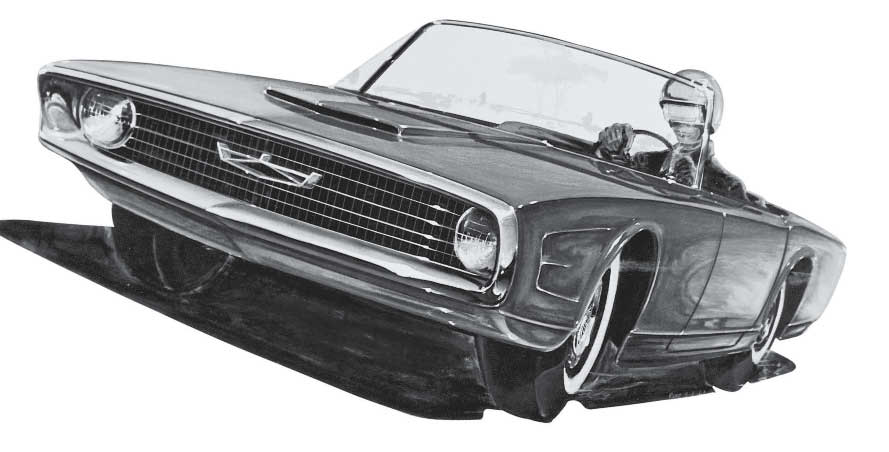
The Thunderbird started life as a small, fun coupe that seated just two occupants. Despite this seating limitation, which went against everything that the “American Family Sedan” had represented (including those built by the Big Three for decades before), the Thunderbird proved that Ford could produce an automobile whose primary purpose was something other than family transportation.
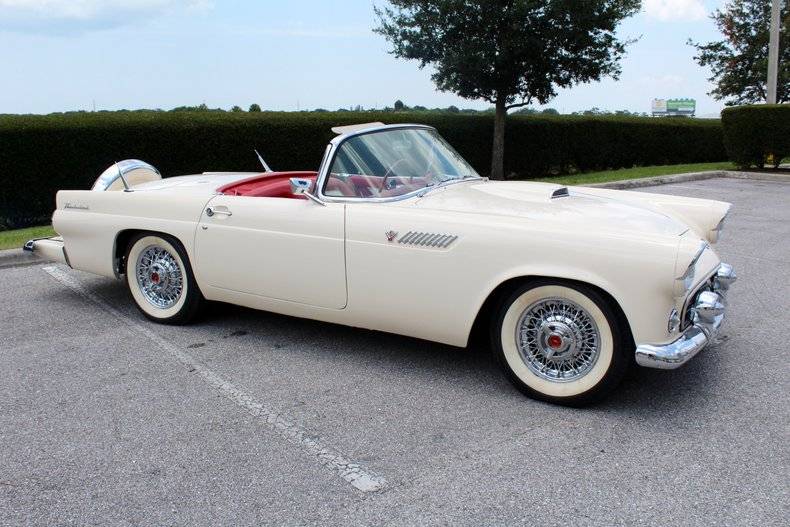
Despite this, the officials in Dearborn, Michigan just couldn’t leave the Thunderbird along, and it wasn’t long before they modified the car’s primary intent by introducing a backseat in 1958. While rumblings suggested that the Thunderbird could not compete with Chevrolet’s two-seat sports car, the car did not suffer for sales numbers. While purists cried out that the Thunderbird should remain a two-seat roadster, the four door version ruled the day with double the sales of its older, two-seater counterparts.
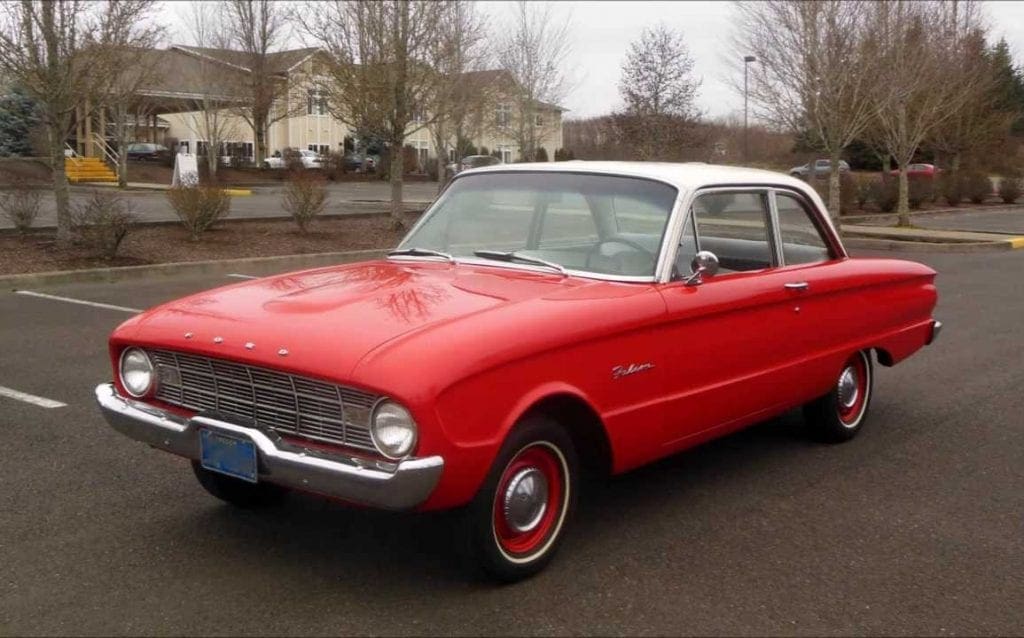
Ford planners continued to explore the emerging two-door sports car market by introducing the affordable, though immensely uninspired, Ford Falcon in 1960. While the car outsold Chevrolet’s Corvair and Plymouth’s Valiant by a margin of 2 to 1, the Galaxy lacked the curb appeal of the earlier Thunderbird. This led some at Ford to wonder what the true sales potential of the Falcon might have been had the company invested more money into its overall appearance. Among those that questioned the Falcon’s true sales potential was then 36-year-old Lee Iacocca.
Lee Iacocca and the Ford Mustang
Much of the success of the Ford Mustang actually began with the promotion of Lee Iacocca to the position of General Manager of Ford in November, 1960. Unlike his predecessor, Robert McNamara, Iacocca recognized that America’s youth were looking for what he called “a good-looking little youth car.” Where McNamara felt that an automobile’s singular purpose was to serve as a utilitarian car that “met people’s basic needs,” Iacocca recognized that a whole-new generation of enthusiasts had emerged that saw an automobile as a means to have fun, seek adventure and enhance sex appeal.
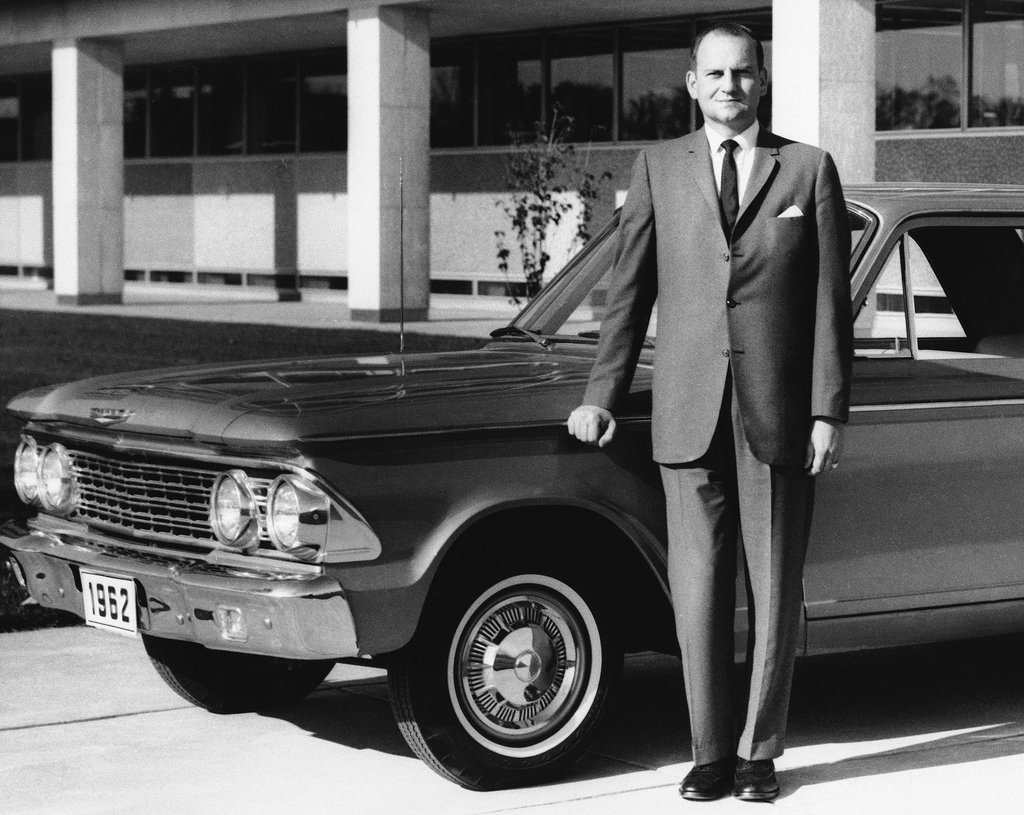
Not long after his promotion in November, Iacocca called together a group of creative automotive visionaries made up of racing guru Jacques Passino, public relations manager Walt Murphy, product planners David Frew, Hal Sperlich and Donald Petersen, and marketing man Bob Eggert. This team, who would become known as the “Fairlane Committee” met every week for more than three months at Darnorn’s Fairlane Motel to begin development of Iacocca’s “Youth Car.”
Within the first few weeks of brainstorming, the “Fairlane Committee” came up with the following design parameters: the car should have a wheelbase of no more than 108 inches, a total weight of just 2,500 pounds and a price tag that was no more than “one dollar per pound.” In addition to these general guidelines, Iacocca also specified that his “youth car” should have a backseat.
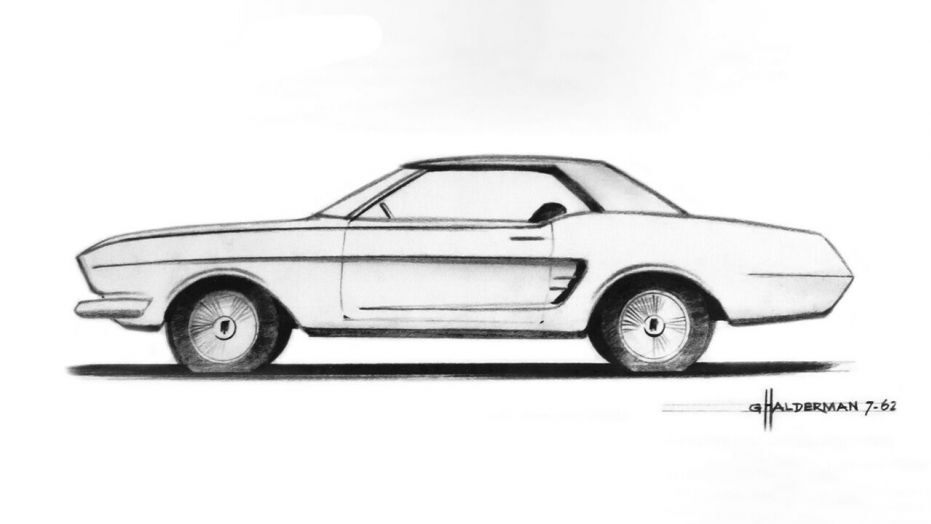
While the team began conceptualizing the car in earnest, it was a sketch created by Ford designer Gale Halderman that really began to define what Iacocca’s new automobile would look like. While the look of the car would continue to evolve, Halderman was credited with proposing the long scoops that run down the length of the Mustang’s sides.
Mustang I – An Introduction
Eugene Bordinat, an automotive styling executive for the Ford Motor Company and head of the Gene Bordinat’s Advanced Styling Studio was tasked by Iacocca with drawing up a series of various sporty two-seat automobiles. By summer 1961, Iacocca himself gave Bordinat the go-ahead to build a full-fledged prototype based on his designs. This prototype, dubbed the “Mustang I” was a topless tow-seater that suggested Ford was developing a true sports car. Even Motor Trend Magazine, in a report they released late in 1963 stated “Ford will produce a sports car to compete with the Corvette.”
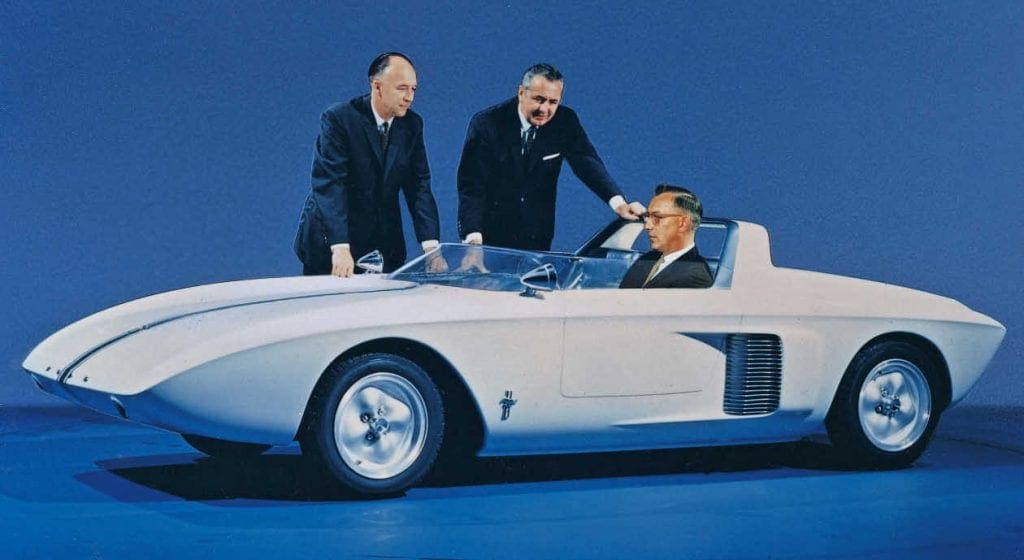
Of course, Iacocca and the “Fairlane Committee” knew that the early iterations of the Mustang – including the 1962 Mustang I – were developed with the sole purpose of familiarizing the buying public with the (as then unknown) Mustang moniker – a charging Mustang with a red,white, blue banner behind it. While the 1962 “Mustang I” definitely looked like an automobile that could rival the Chevrolet Corvette, the final product that Iacocca (and team) had in mind was an entirely different animal.
From “Cougar” to “Mustang”
Development of the Mustang began in earnest in early 1962, and six mockups were presented to division management in August of that same year. Of these different iterations, Bordinat indicated that the best of this batch of prototypes was a car they’d dubbed the “Cougar.” Created by David Ash under the direction of Joseph Oros (another of Ford’s automotive styling executives), the Cougar’s design continued forward with few major changes from concept to full realized prototype to the eventual production model design.
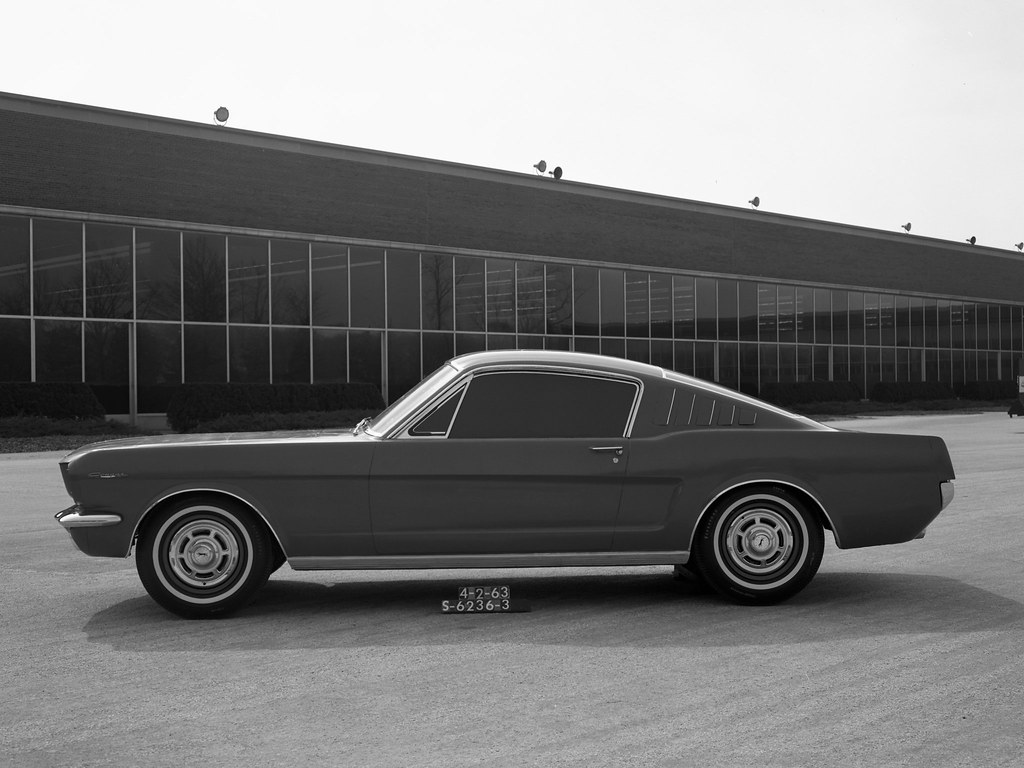
While the design was a monumental success, the “Cougar” name was not.
When Iacocca and his team began development of his “youth car,” Ford cataloged everything related to its development under the in-house project code “T-5.” Throughout the car’s three year evolution, it took on a number of different names including the aforementioned “Cougar” as well as Henry Ford II’s personal preference, the “T-Bird II.” In the end, the Mustang moniker best described the look and feel of the car – and so it became the name embraced by all involved.
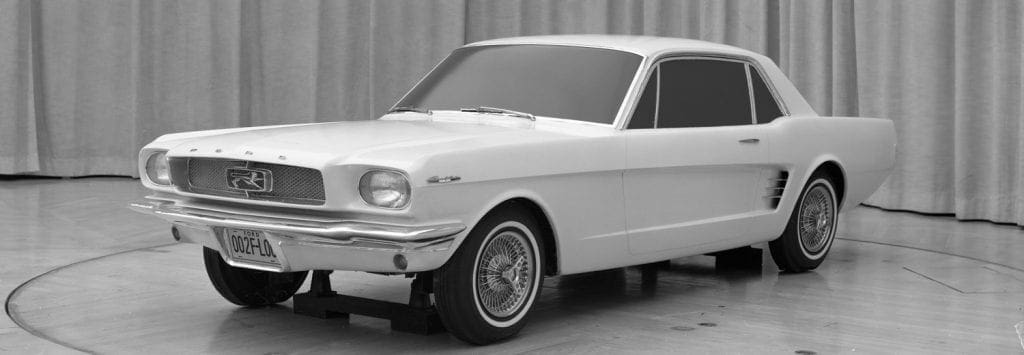
On September 10, 1962, Lee Iacocca took the final variant of the Oros/Ash Mustang to Henry Ford II’s office for final approval. He received the approval he hoped for, but has also gone on record as saying that gettin Henry Ford II’s sign-off was one of the “toughest selling jobs of (his) career.” Still he received a thumbs-up to move forward with production but received a meager $40 million dollar budget to develop and tool-up the Mustang. He was also given a very tight deadline: “Job One” (the name given to the very-first production Mustang ever), was slated to leave the assembly line on March 9, 1964.
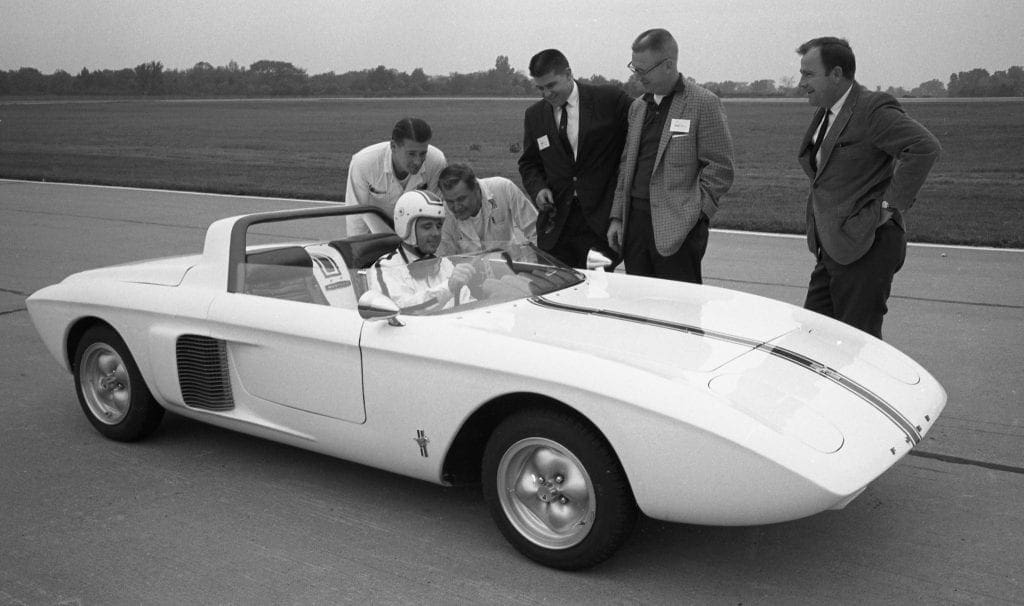
Ford’s original Mustang (the Mustang I) was ready for public unveiling by October 2, 1962. The car was shipped to Watkins Glen in New York where it was formally introduced to the press and, in turn, the world. Car and Driver Magazine called the Mustang I “the first true sports car to come out of Dearborn (Michigan.)” The car wasn’t just put on exhibit. Dan Gurney took the car out on the racetrack where he reportedly achieved speeds reaching 120 miles per hour in the small, two-seat automobile. Unfortunately, the car presented – a genuine two-seater – was not what Ford had any intention of building as their production model. This car was purely to build hype around the branding. It gave Ford the necessary “buzz” to keep momentum behind the marketing of their soon-to-be pony car, but left some wondering how the world would receive the Mustang that was still two years in the future.
Production and Promotion
Fortunately, Lee Iacocca had given his engineering division the heads-up that they were to adapt as much of the earlier Ford Falcon’s platform as possible. This received appreciable criticism from the automotive press who argued that the new Mustang was little more than a reworking of the older Falcon.
In some respects, the critics were correct. On the surface, the Ford Mustang was a groundbreaking new automobile that exuded a sense of speed and an aura of sensuality. However, underneath the surface were many of the “not so fast” remnants of it’s Falcon forefather.
“The Mustang had a lot of Falcon parts in it,” says Gale Halderman, “but it was not a glorified Falcon as many believe.”
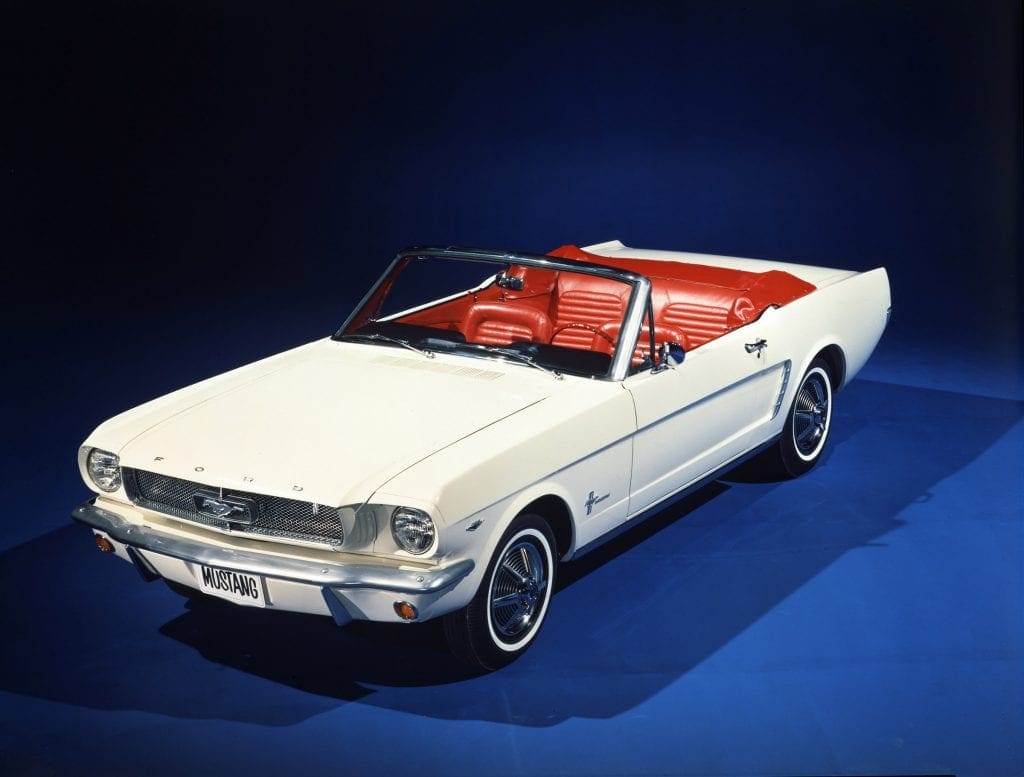
Outside members of the Ford Motor Company itself, the first people to learn about the new Mustang were prominent magazine journalists who were invited to a confidential briefing about the car in the fall of 1963. Following this initial press release, Ford released press kits to approximately 11,000 newspapers and magazines. This, in turn, was followed by the official press introduction on Monday, April 13, 1964 at the New York World’s Fair.
Just three days after the press introduction in New York, Ford began an unprecedented barrage of Mustang television commercials on all three networks. These ads were released and coordinated to air at the same time, so that regardless of the channel, all viewers were able to view the new marketing material that Ford had created. In addition, endless print ads began popping up in every major newspaper and magazine publication. It seemed as if, overnight, the world was saturated with marketing for the new Mustang. Little did Ford realize the impact such an aggressive marketing campaign would have on the buying public.
The advertising for the new Mustang was in-keeping with Iacocca’s vision of developing a “youth car.” It was specifically targeted at emerging baby boomers. According to Iacocca, another important facet of the advertising campaign involved focusing on the “three faces of Mustang.”
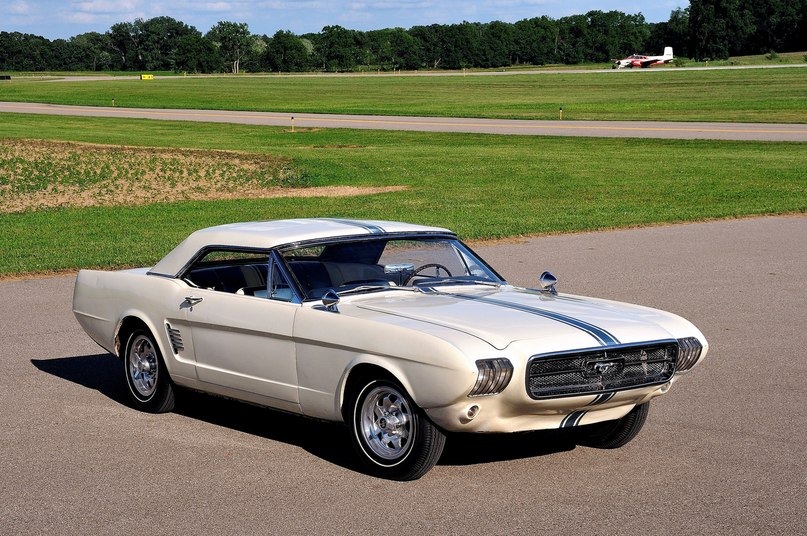
The 1963 Mustang II
Given the success of the Mustang’s unveiling at Watkins Glen the previous year, Gene Bordinat decided to return to Watkins Glen in October, 1963 with another Mustang. This new car was a departure from the small, two-seat coupe that had been introduced to the public. Instead, this new-version of the Mustang served more as a link between that early iteration and the actual production Mustang pony-car that was being developed. Dubbed the Mustang II, the car was basically a standard, pre-production model of the Mustang. It featured customized nose and tail treatments and a lowered roof. Like the Mustang I, this concept vehicle also featured a white paint scheme with blue racing stripes.
According to Lee Iacocca, the introduction of the Mustang II at Watkins Glen in 1963 was part of “a pre-test of likely customer responses to styling and mechanical innovations we may be considering for future production models.”
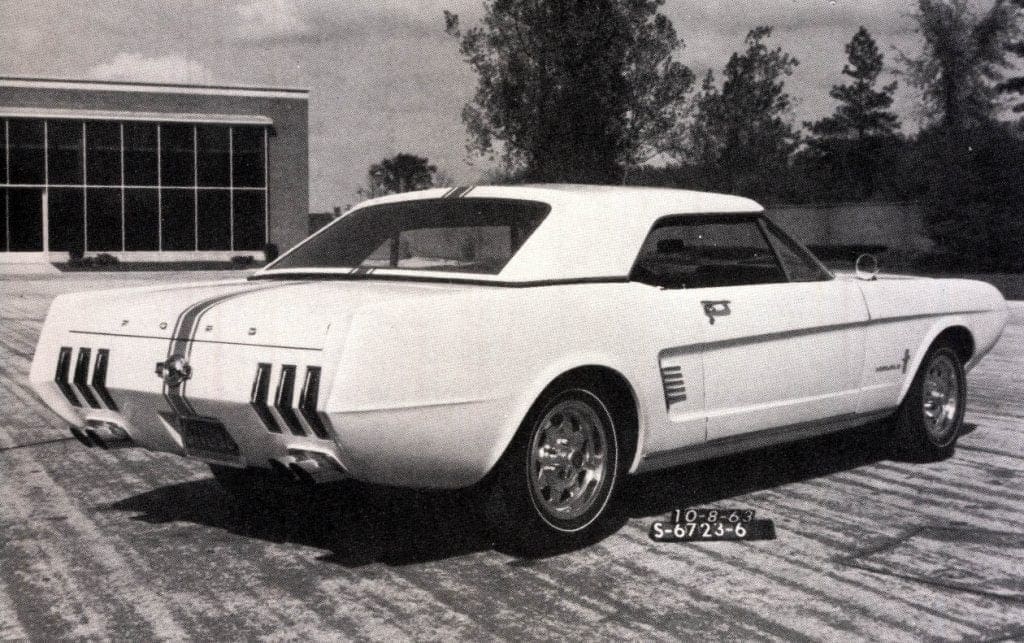
The actual reason for its introduction at “the Glen” in 1963 was to test the automotive press with this second iteration of the Mustang and to obtain a pulse on how well the car would be received by the public. The Mustang II was not well received…at all.
Motor Trend’s journalists couldn’t believe their eyes. Early reports published by the automotive magazine stated that the “Mustang II may herald the general lines of that division’s upcoming sports car, but it likely isn’t an actual prototype. It resembles the original Mustang not at all. It’s rather a shame that the Mustang name had to be diluted that way.”
Of course, Ford had already endeavored to move forward with production of their pony car. The early response to the Mustang II may have lacked the anticipation and interest of its earlier counterpart, but the car was within six months of becoming commercially available and Ford was pressing onward with meeting the early demand already in-place by an anxiously awaiting public.
The Three Faces of Mustang
To make the Mustang desirable to a much broader audience, Iacocca knew that he needed to make it affordable to a number of different financial demographics. To accomplish this, he (along with the sizable engineering group behind the Mustang) developed three different engine platforms and two different body styles.
In 1964, consumers could purchase a Mustang equipped with a base-level six-cylinder engine. Customers looking to spend a bit more could purchase a convertible option equipped with the six-cylinder engine that was a bit of a throwback to the luxurious Thunderbird from a decade earlier. Finally, if buying a car that promised performance to go with its good looks, a would-be buyer could purchase the optional Ford High Performance 289 V-8 engine that delivered an impressive 271-horsepower (although this option would not become available until June, 1964.)
While two bodystyles were initially offered – the aforementioned notchback coupe and convertible – a third variation known as the 2+2 fastback was introduced in September 1964.
Overnight Success
As stated at the beginning, the Mustang became an overnight phenomenon. In response to the aggressive and dynamic marketing campaign that had been developed to promote the Mustang prior to its official release, the media picked up the torch and continued to promote the Mustang in earnest, much to the delight of Ford’s top brass. Almost overnight, Lee Iacocca and his new Mustang were on the cover of every major magazine publication, even showing up concurrently on both Time and Newsweek!
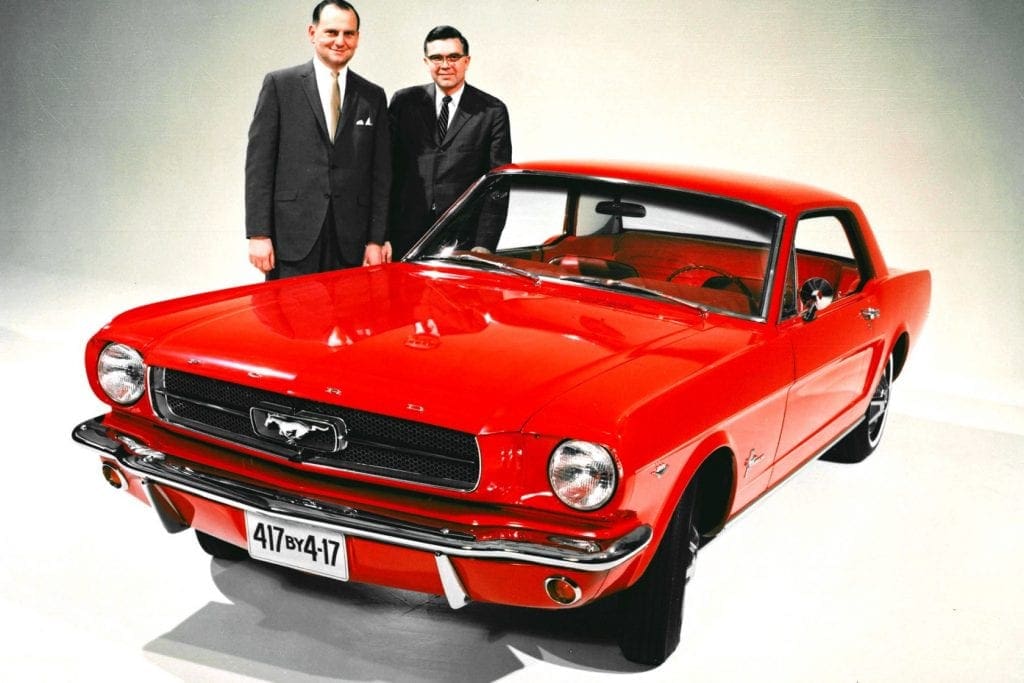
In fact, there were few complaints about the car itself, only the ability to obtain one from a local Ford dealership. While original claims stated that no more than 100,000 new Mustangs would be produced in 1964, Lee Iacocca knew that the car would easily outsell that number. His goal from the very start was to break Detroit’s new-model first-year sales record (which, ironically, had been set by sales of the Ford Falcon – which sold approximately 417,000 units just four years prior.) The battlecry around Dearborn became known as “417 by 4-17” meaning that Ford was expected to sell at least 417,000 pony cars by April 17, 1965 (one year, almost to the day, after the Mustang’s introduction at the World Fair.)
This proved to be no problem at all. By April 17, 1965, Ford had actually sold 418,812 of their Mustangs, breaking their own record by 1,638 units (Mustangs vs. Falcon.) Of that record-breaking total, 121,538 Mustangs were dubbed 1964-½ Mustangs because they were introduced late in the model year.
NEXT: More research on the First Generation Mustang


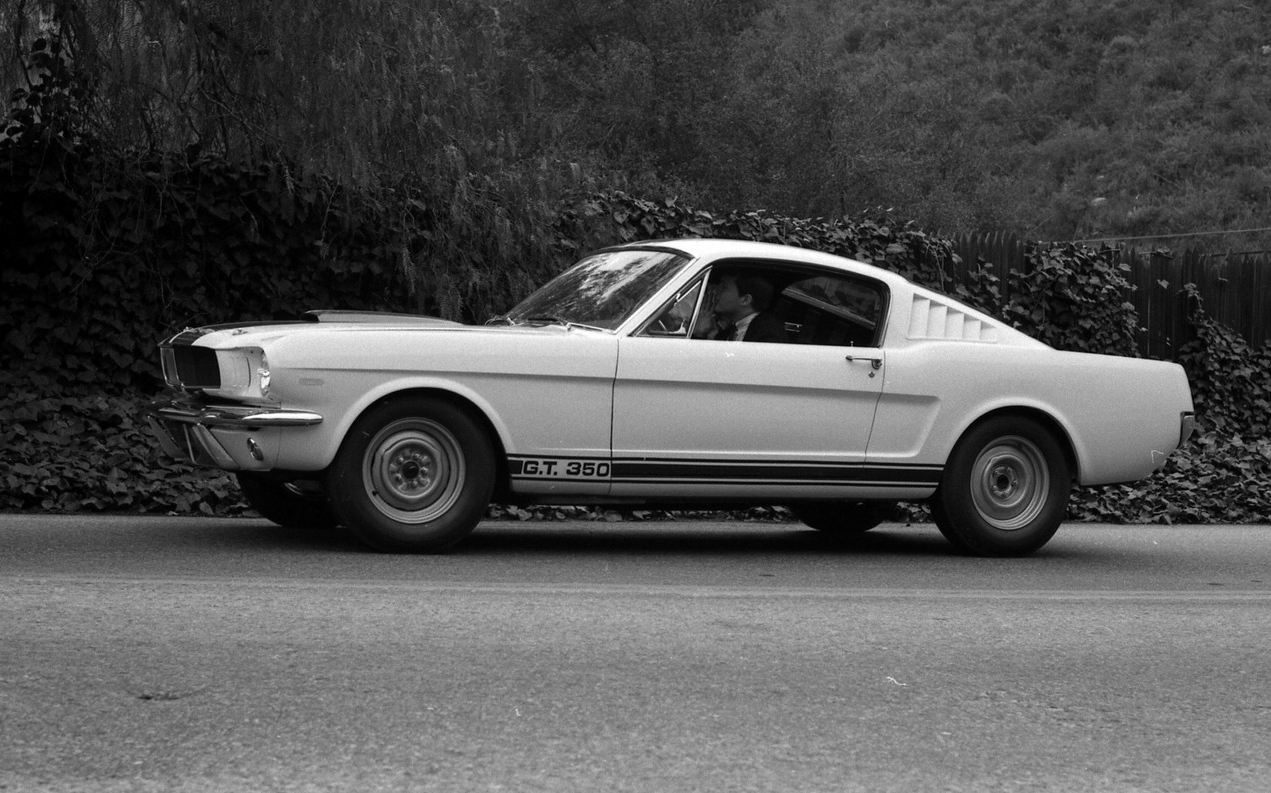


Good morning,
We have a 1965 Mustang fastback with the #5F09A****** Ford serial number stamped in three places on the inner front fenders. The car appears to be a Shelby GT-350 but I’ve been told (emphatically) that all GT-350’s have K code engines, but I’ve also found on the internet that some of the 65 Shelby’s were built from cars with an “A” code 5th digit.
Can you help me with this matter? Thank you.